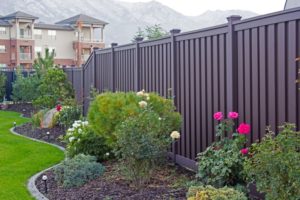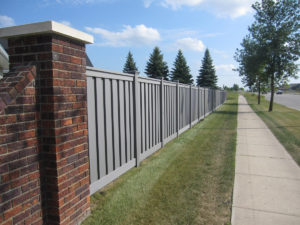
When Trex hit the market in 1996 with their decking product that was an alternative to wood, they were the first company to combine reclaimed wood with recycled plastic. This combination created a sustainable and extremely durable product that homeowners began implementing right away when they learned the benefits. The unique decking product does not require sanding or staining, and will not warp, rot, or splinter; meaning a long life with low maintenance.
Today, Trex has even more applications than just decking and remains a eco-friendly choice due to the green nature of the product. Trex composite fencing has become very popular in recent years for good reason. We’ll show you why it can be a better choice over wood or vinyl fencing, and give an example of how it’s used on a large municipal scale as well.
Going Green with Your Fence

Trex fencing is made in the United States with 96% recycled content made up of reclaimed wood and plastic materials, and the company is one of the largest plastic recyclers in the world.
Trex is a member of the U.S. Green Building Council (USGBC), which is the nation’s primary coalition of leaders from every sector of the building industry. In addition, Trex products contribute to LEED points for those businesses or commercial applications that are focusing on that certification. LEED (Leadership in Energy and Environmental Design), is a point-based system for green building standards, developed in part by the USGBC.
Trex Fencing Provides Unmatched Durability
The blend of wood and plastic in Trex composite fencing makes it a durable product not vulnerable to insect damage or tough weather conditions. In fact, it is far more durable than cedar or vinyl fences and comes with a 25-year warranty from the manufacturer.
If you live in Colorado, you know that we can get pretty intense winds throughout the year. A Trex fence can withstand winds up to 120mph, ensuring you won’t come out to your yard with a downed fence after a storm. The interlocking-picket design of Trex fencing distributes the stress from wind evenly across the fence line making each section incredibly strong.
While Trex composite fencing does not require painting or staining, it can be done if the homeowner desires. But most people love the idea of never having to paint or stain their fence, knowing it will not degrade aesthetically over time.
Related Blog Post: Using Trex Fencing as a Fire Mitigation Tool Around Your Home

The Undeniable Curb Appeal of Trex Fencing
It’s tough to find a long-lasting, low maintenance fence that is also nice to look at. But Trex fencing achieves this in two ways. The assorted color options offer great choices that can be matched to your home, your landscaping, or just your preference. In addition, the top and bottom rails provide framing for the fence, adding to its attractive nature.
Another benefit is the privacy that a Trex fence provides. There are no gaps between pickets, due to the interlocking design.
The curb appeal, when combined with the sustainability and durability factors, make the cost of Trex fencing very worth it for most homeowners.
Case Study: Trex Fence Provides Perfect Solution Alongside Metropolitan Lightrail System
A fantastic example of the strength and durability of Trex fencing can be found in Utah next to a lightrail system. In Salt Lake City, the Draper and Mid-Jordan Lightrail projects were in their final stages of construction when the project engineers and the municipalities involved opted for Trex fencing to achieve four primary objectives: sound suppression, strength, aesthetics, and cost.
The interlocking picket system not only helped to inhibit noise transference from the lightrail trains, it also provided a solid privacy fence to the homes on the other side. Plus, the Trex fencing reduced the need for fasteners, and looked aesthetically pleasing on both sides.
Trex met the unique design requirements for this project and built a custom height of 12 feet for this fence along the lightrail; the standard heights for Trex fencing are six and eight feet tall. A six-foot Trex fence successfully withstood a test of 130mph sustained winds and 147mph gusts, convincing the project engineers it was the right choice for fencing that will endure the constant force of air pressure from the trains moving through narrow corridors. The combined length of this fence exceeds 18,000 linear feet.
More and more now, Trex has become a product of choice for government projects, especially with its associated LEED points. It has been installed at federal, state, and municipal properties throughout the United States.
